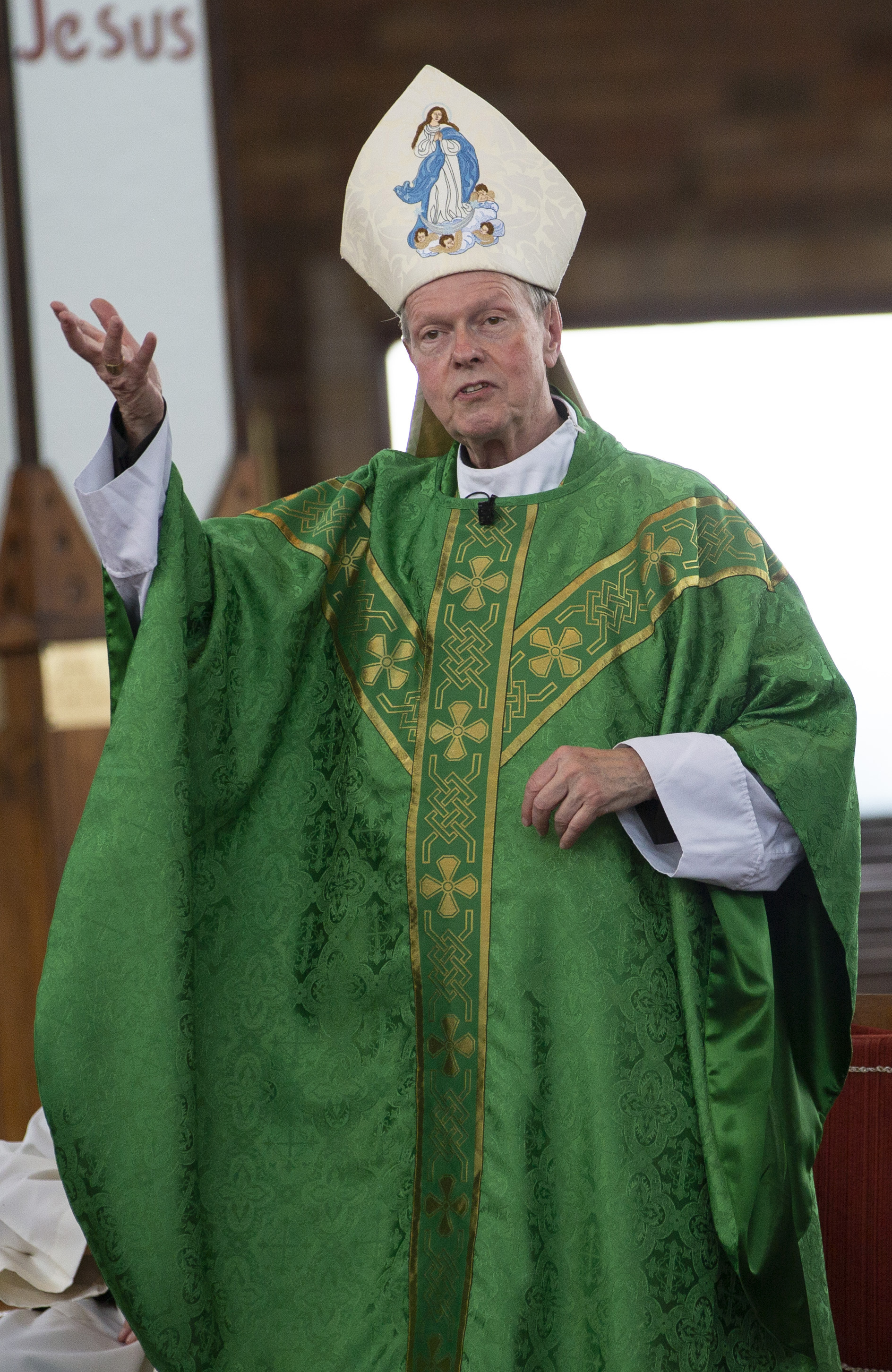April 6, 2018 at 1:53 p.m.
Cathedral ready for its face-lift
Ludwig Pauli, whose titles include Master Stone Mason, and Stone Carver and Restorer, is busy dressing the 150-year-old structure with a new brownstone facade.
The first shipment of stone recently arrived at the Cathedral from Realstone Fabrication in Derbyshire, England. It was quarried from the Cumbria region there.
Cemented in place
Mr. Pauli hails from the 900-year-old city of Passau, located at the southeastern tip of Germany where the Danube River of Austria joins the Inn River of the Czech Republic and the Ilz of Bavaria.He has been in the U.S. since last October, planning the massive task of repairing and replacing the brownstone veneer on the Cathedral.
In addition to directing the placing of new stone over the brick skeleton of the Cathedral, he will be teaching the art of stone-cutting and carving to apprentices who will work on the site at the Cathedral stone shop, a temporary structure added to the grounds for the next 30 months.
Guilded life
Mr. Pauli has a long history of cutting, carving and teaching the art of stone masonry to students in the trade schools of Munich and Ingolstadt, Germany. His life-long dedication to the specialty of working with brownstone is the result of an even longer European tradition known as the craft guild.For nearly a thousand years, skilled artisans such as stone-cutters, masons, carpenters and bricklayers have been combining their efforts to construct edifices across the European continent. These structures include the famous cathedrals of England, France, Spain and Germany that sometimes took hundreds of years to complete.
Beginning in the 12th century, artisans who worked on such structures banded together to form guilds to protect the workers against competition as well as to ensure a high level of skill and quality in the artisan's finished product.
Through the ranks
Eventually, these organized groups of workers developed three classes:* the master, who owned the tools and raw material of his trade and taught it to
* the apprentice who was a beginner in the trade and learned it under the direction of the master, and
* the journeyman, who had completed his apprenticeship and was paid a fixed wage for his labor.
The craft guilds of medieval Europe were the forerunners of trade unions.
Master worker
Mr. Pauli has been a master mason for 28 years. In Germany, he told The Evangelist, all those who teach these crafts must be certified masters of their trade."One must be a master in order to teach any of the stone crafts," he explained. "While some countries in Europe no longer require this level of skill, both Germany and Switzerland continue to do so. In this way, we can assure our students that they will receive the most highly skilled instruction."
According to him, the guild system also elevates the level of skill provided by the artisan, who takes great pride in his work. Honing his skills
For the past 28 years, Mr. Pauli has contracted his services throughout Europe and, now, the U.S. He began his apprenticeship at 23, a little later than most, who start at 16 or 17.
"I studied politics for a while and then realized that I wanted to be a stone mason," he noted. "For me, though, the normal three years of apprenticeship were completed in two. That is because I was more mature and knew that this was really what I wanted to do with my life."
Achieving the status of master mason took him two more years. Once he did so, he was able both to work on his own and to teach his craft.
Peripatetic life
During the next 18 years, Mr. Pauli traveled throughout Germany to work on structures that included monasteries, churches and chapels. The oldest building he has ever worked on was a 12th-century abbey in Bavaria."I was amazed at the high level of skill the artisans of that time had," he said. "One could see how intricate and delicate the work was."
Although he has worked in some of Europe's cathedrals, most of his experience has been on smaller projects in cities such as Munich, Dresden, Augsburg and Passau. After the fall of the Berlin wall in 1989, Mr. Pauli participated in extensive modern construction work throughout Eastern Germany and also completed work in Zurich, Switzerland. His U.S. experience includes work at the American Military University in Manassas Park, Virginia.
In charge
On the Cathedral project, Mr. Pauli oversees the work of nine artisans from the Bricklayers and Allied Craftworkers Union Local No. 2 of Albany. These artisans include carpenters, bricklayers and masons who work in partnership with Gannem Construction and the architectural firm of Mesick, Cohen, Wilson and Baker.Mr. Pauli, who has contracted his services for three years, expects that he might be here longer. Work on the project has been slowed by the late shipment of stone.
The stone shop is located on the west end of the Cathedral near the parking lot. When apprentices have been chosen and the stone saw arrives from Germany, cutting and carving will begin. The general public will be able to watch this ancient process through observation windows along the wall.
'Renewal'
Rev. William H. Pape, rector of the Cathedral, noted that among the church's restoration committee and staff, there is a lot of excitement in seeing the process unfold."Watching the rebuilding of our Cathedral is a unique opportunity for everyone to learn about this process," he said. "From the diocesan point of view, it is not just a renewal of the building. It is also a renewal of people's lives in this Diocese.
"The concept of the stone shop and the skill of the carving of stone as taught by the master mason to his apprentices is a very important part of this entire job. We think it is a wonderful educational tool because people will be able to watch this ancient art being passed on to the next generation."
(07-19-01) [[In-content Ad]]
MORE NEWS STORIES
- Doctor of the church, Hiroshima & Nagasaki anniversary, Ireland pilgrimage | Week in Review
- Washington Roundup: Senior US officials visit Gaza amid hunger crisis, Trump announces new tariffs
- Generative AI poses new threats of child sexual abuse, experts say
- Exiled Nicaraguan bishop says award recognizes ‘tireless struggle’ for justice in homeland
- Dialogue, 2-state solution must end long-running Israeli-Palestinian conflict, Vatican tells UN
- For Catholic colleges, nation’s ‘demographic cliff’ poses challenges, prompts closures
- Thousands visit Blessed Frassati’s remains in Rome for Jubilee of Youth
- Making St. John Henry Newman church doctor is a ‘huge encouragement’ to British Catholics
- Q&A with the new president of Vatican’s Pontifical Academy for Life
- Court dismisses case against prominent exorcist priest







Comments:
You must login to comment.